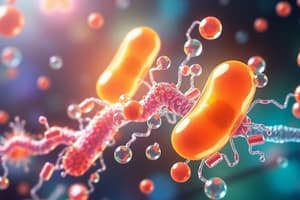Podcast
Questions and Answers
What is the primary mechanism of action of Penicillin in inhibiting bacterial cell wall synthesis?
What is the primary mechanism of action of Penicillin in inhibiting bacterial cell wall synthesis?
- Inhibition of peptide synthesis
- Inhibition of bacterial DNA replication
- Inhibition of cell membrane formation
- Inhibition of transpeptidation (correct)
What is the effect of Penicillin on autolytic enzymes in bacteria?
What is the effect of Penicillin on autolytic enzymes in bacteria?
- It destroys the enzymes
- It has no effect on their activity
- It inhibits their activity
- It activates their activity (correct)
What is the name of the protein that Penicillin binds to in the bacterial cell membrane?
What is the name of the protein that Penicillin binds to in the bacterial cell membrane?
- Penicillin-releasing proteins
- Bacterial membrane proteins
- Penicillin-binding proteins (correct)
- Cell wall synthesis proteins
Which of the following antibiotics is considered the last line of defense against MRSA?
Which of the following antibiotics is considered the last line of defense against MRSA?
What is the common concern associated with the use of Beta-lactam antibiotics?
What is the common concern associated with the use of Beta-lactam antibiotics?
Which of the following antibiotics is only used topically?
Which of the following antibiotics is only used topically?
What is the primary mechanism of bacterial resistance to macrolides?
What is the primary mechanism of bacterial resistance to macrolides?
What is the mode of action of Fluoroquinolones?
What is the mode of action of Fluoroquinolones?
Which type of bacteria are macrolides commonly used to treat?
Which type of bacteria are macrolides commonly used to treat?
What is a concern with the use of Fluoroquinolones?
What is a concern with the use of Fluoroquinolones?
What is the effect of macrolides on bacterial cells at higher concentrations?
What is the effect of macrolides on bacterial cells at higher concentrations?
What is the target of Rifampin in bacterial cells?
What is the target of Rifampin in bacterial cells?
What is the primary function of enzymes such as DNA gyrase and topoisomerase IV in bacterial DNA?
What is the primary function of enzymes such as DNA gyrase and topoisomerase IV in bacterial DNA?
What is the result of fluoroquinolones inhibiting DNA gyrase and topoisomerase IV?
What is the result of fluoroquinolones inhibiting DNA gyrase and topoisomerase IV?
What type of activity do fluoroquinolones exhibit against bacteria?
What type of activity do fluoroquinolones exhibit against bacteria?
What is the primary mechanism of resistance to tetracyclines in bacteria?
What is the primary mechanism of resistance to tetracyclines in bacteria?
How do macrolides inhibit bacterial protein synthesis?
How do macrolides inhibit bacterial protein synthesis?
What is the primary effect of macrolides on bacterial cells?
What is the primary effect of macrolides on bacterial cells?
What is the ultimate result of the inhibition of DNA replication and transcription by fluoroquinolones?
What is the ultimate result of the inhibition of DNA replication and transcription by fluoroquinolones?
What is a characteristic of the spectrum of activity of fluoroquinolones?
What is a characteristic of the spectrum of activity of fluoroquinolones?
What is the ultimate consequence of macrolide binding to the ribosome?
What is the ultimate consequence of macrolide binding to the ribosome?
What is the primary mechanism of action of rifampin in inhibiting bacterial growth?
What is the primary mechanism of action of rifampin in inhibiting bacterial growth?
Which of the following is a characteristic of rifampin?
Which of the following is a characteristic of rifampin?
What is the primary site of action for macrolides?
What is the primary site of action for macrolides?
What is the scope of activity for tetracyclines?
What is the scope of activity for tetracyclines?
What is the primary target of sulfonamides in bacterial cells?
What is the primary target of sulfonamides in bacterial cells?
What is the result of sulfonamides inhibiting folic acid synthesis in bacteria?
What is the result of sulfonamides inhibiting folic acid synthesis in bacteria?
What is a common mechanism of bacterial resistance to rifampin?
What is a common mechanism of bacterial resistance to rifampin?
What is the purpose of using rifampin in combination with other antibiotics?
What is the purpose of using rifampin in combination with other antibiotics?
Flashcards are hidden until you start studying
Study Notes
Major Targets for Antibacterial Action
- Cell wall synthesis
- Nucleic acid synthesis
- Metabolic processes
Antibiotics that Target Cell Wall Synthesis
- Penicillin (Penicillins, Ampicillin, Carbenicillin, Amoxicillin, Methicillin)
- Mode of action: inhibit transpeptidation and activate autolytic enzymes
- Target organisms: Gram-positive organisms
- Special concerns: allergies, beta-lactamase
Antibiotics that Target Nucleic Acid Synthesis
-
Fluoroquinolones (Ciprofloxacin, Ofloxacin, Lomefloxacin)
-
Mode of action: inhibit DNA gyrase and topoisomerase IV, blocking DNA replication and transcription
-
Target organisms: Gram-positive and Gram-negative bacteria, including mycobacteria
-
Special concerns: increasing resistance, quick resistance development
-
Macrolides (Rifampin)
-
Mode of action: inhibit protein synthesis by binding to the 50S ribosomal subunit
-
Target organisms: Gram-positive and Gram-negative bacteria, including mycobacteria
-
Special concerns: bactericidal activity, modification of the ribosomal binding site, efflux pumps
Antibiotics that Inhibit Metabolic Processes
- Sulfonamides (Gantrisin, SXT, Bactrim)
- Mode of action: inhibit folic acid synthesis by imitating PABA
- Target organisms: Gram-negative and some Gram-positive bacteria
- Special concerns: allergic reactions, sun sensitivity, synergistic use with trimethoprim
Studying That Suits You
Use AI to generate personalized quizzes and flashcards to suit your learning preferences.




